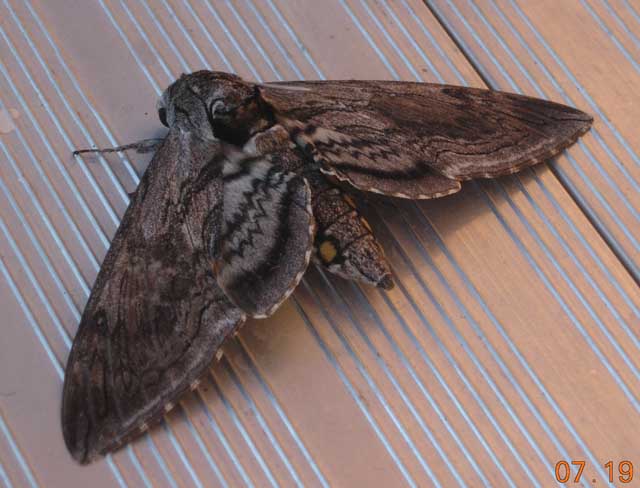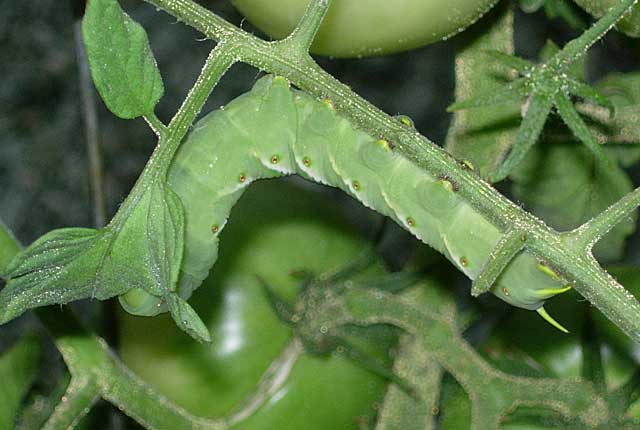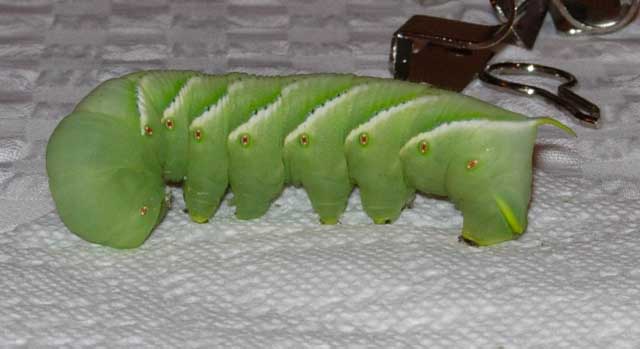Fremont County, Colorado
Sphingidae

Manduca quinquemaculatus July 19, 2009, near Canon City, Fremont County, Colorado, courtesy of Karen Zak.
|
|
Updated as per James P. Tuttle's The Hawk Moths of North America, July 20, 2009 Butterflies and Moths of North America, July 20, 2009 |

This site has been created by
Bill Oehlke at oehlkew@islandtelecom.com
Comments, suggestions and/or additional information/sightings are welcomed by Bill.
This page is inspired by and dedicated to
Karen Zak who sent the image of the Manduca quinquemaculatus
moth at top of the page.
Karen writes, July 19, 2009, "Thank you for your web site!! It helped me identify the subject moth my husband caught on the outside wall of our garage. We live south and a
little east of Canon City in Fremont County, Colorado. Attached are some photos I took which helped me identify it."
Karen has also sent images of what I believe is a very close relative to Manduca quinquemaculatus. The images below seem a very good match for Manduca sexta. Usually in the final instar Manduca quinquemaculatus have a black anal horn, while final instar larvae of Manduca sexta have a red anal horn. I think this is a fourth instar larva, and the red horn would appear in the next molt. I have also noticed, however, that Manduca sexta larvae from western states have less red on anal horn as compared to those from the eastern states.

Manduca sexta fourth instar?, Canon City, Fremont County, Colorado, July 18, 2007, courtesy of Karen Zak.

Manduca sexta fourth instar?, Canon City, Fremont County, Colorado, July 18, 2007, courtesy of Karen Zak.
A "WO" after the species name indicates that I (William Oehlke) expect that this moth is present or might be present, although unreported. A "USGS" indicates the moth is confirmed on USGS site.
Please help me develop this list with improved, documented accuracy by sending sightings (species, date, location), preferably with an electronic image, via email to Bill Oehlke.
Sphinginae subfamily
Smerinthini Tribe:
Macroglossinae subfamilyDilophonotini tribe:
Philampelini tribe:
Macroglossini tribe:
|
Enjoy some of nature's wonderments, giant silk moth cocoons. These cocoons are for sale winter and fall. Beautiful Saturniidae moths will emerge the following spring and summer. Read Actias luna rearing article. Additional online help available.
Eggs of many North American species are offered during the spring and summer. Occasionally summer Actias luna and summer Antheraea polyphemus cocoons are available. Shipping to US destinations is done from with in the US.
Use your browser "Back" button to return to the previous page.
This page is brought to you by Bill Oehlke and the WLSS. Pages are on space rented from Bizland. If you would like to become a "Patron of the Sphingidae Site", contact Bill.
Please send sightings/images to Bill. I will do my best to respond to requests for identification help.
 Show appreciation for this site by clicking on flashing butterfly to the left. The link will take you to a page with links to many insect sites. |